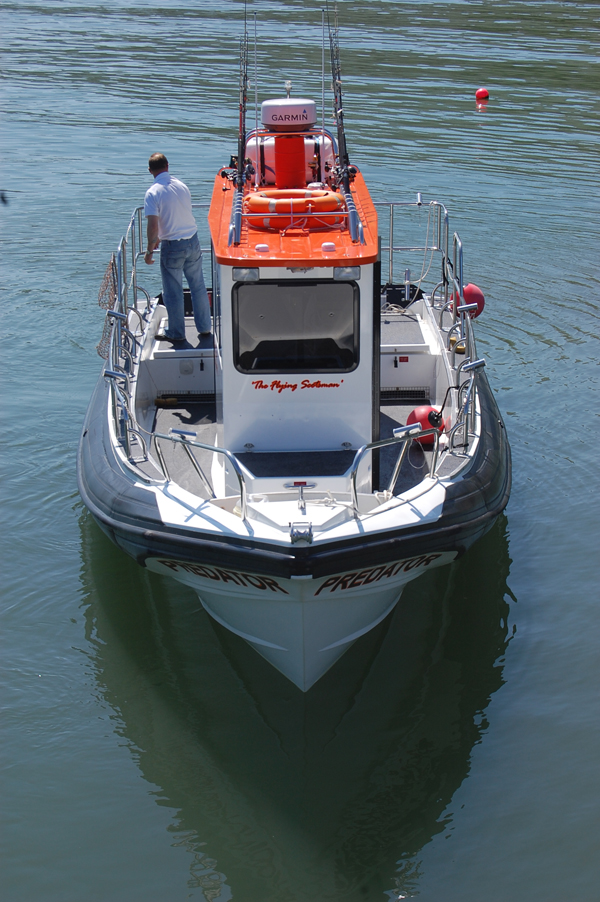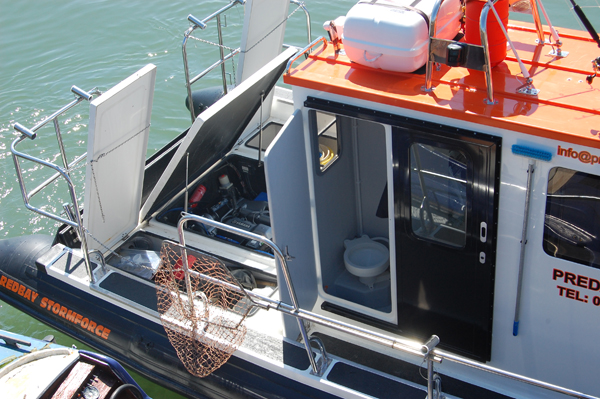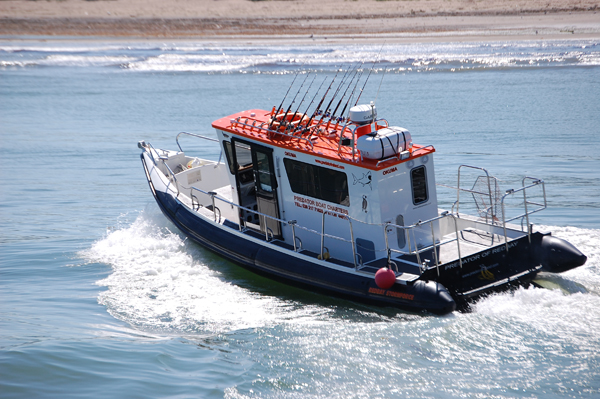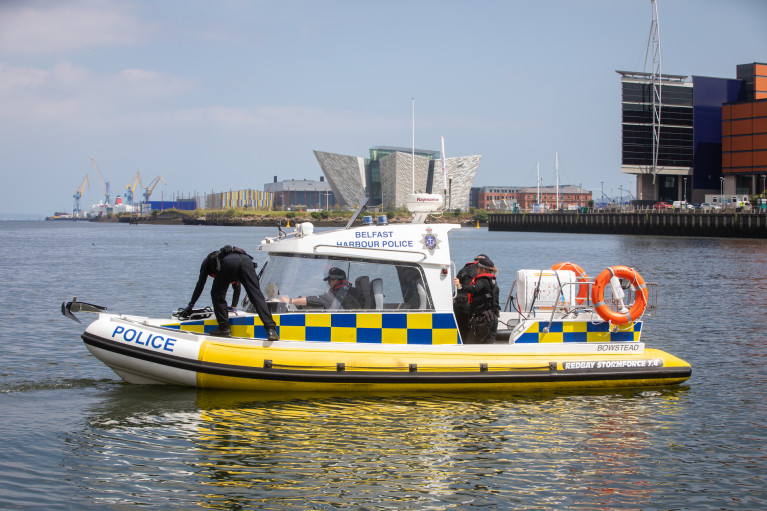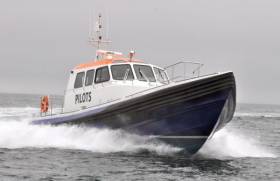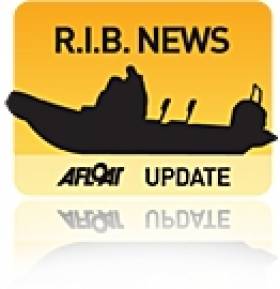Displaying items by tag: redbay boats
Kenmare's Customised Red Bay Stormforce 1450 RIB Brings the Skelligs Within Easy Reach
Way back in the dim and distant OtherTime, back in the vaguely-remembered May of last year when we still hadn't really grasped how our lives had been totally pandemically changed, we ran a story about how super-host John Brennan of Kenmare and his son Adam were working with Redbay Boats of the Glens of Antrim to create the ultimate personalised variant of the northern firm's Stormforce 1450.
Well, despite everything that has been done or imposed or thought up to foul up cross-border trade and the exchange of ideas, the new machine is now cutting a dash on the Kenmare River and the ocean beyond, and doing so to such good effect that the Brennan hotel group can offer you a handy jaunt out to the Skelligs before stopping off somewhere agreeable for lunch.
The constraints of using the giant RIB configuration will sometimes result in a rather unsightly super-structure. But as our header pic of a sister-ship indicates, the design team at Cushendall have come up with something uniquely attractive in itself, while the fact that it does the business is shown in this vid of the Skelligs voyage experience by Nick Burnham of Aquaholic
And if you fancy the complete guided tour of the boat, try this for size:
 An alternative layout for the Stormforce 1450
An alternative layout for the Stormforce 1450
Belfast Harbour Police has welcomed the arrival of its first fully equipped Police boat which will improve water safety and crime prevention along the city's popular waterfront.
The patrol boat which forms part of a programme of investment in water safety, is named Bowstead, after John Bowstead, the first Constable appointed to police the quays in Belfast during 1824.
Bowstead will operate on waterways within Belfast Harbour, focusing on public access quays and areas popular with visitors.
A fully trained crew of Belfast Harbour Police Officers will be supporting the Harbour’s ambition to be a safe and attractive place for everyone.
The boat was manufactured by Redbay Boats in Cushendall, Co. Antrim and will also support Belfast Harbour Police’s joint operations with Lagan Search and Rescue, the PSNI and Border Force.
#PilotBoats - Belfast Harbour has completed its £2 million deal with Redbay Boats for two new pilot boats to service the city’s busy waterfront, as The Irish News reports.
Already on service is the Captain Michael Evans named after the Belfast’s former deputy harbour master who was killed in the Manx2 Flight 7100 crash in Cork in 2011.
It’s now been joined by the Ben Madigan — also a Stormforce 1650, a new design by Redbay Boats based in Cushendall, Co Antrim, and celebrating 40 years in business this year.
The Irish News has more on the story HERE.
Redbay Commercial Ribs Produced By Northern Ireland Firm
Whatever your business, Redbay Boats have many years experience working with the various regulatory bodies to provide safe and seaworthy craft for commercial operations the world over. Projects both in the UK and abroad have included:
- Fishery Protection Vessels
- Ballistically protected drug enforcement vessels
- Coastguard rescue and patrol vessels
- Survey vessels for both seabed and
- environmental applications
- Search and rescue lifeboats
- Fire support and airport rescue vessels
- Navy, military and police vessels
-
Small passenger ferry vessels
The Stormforce range is extensive with RIB boats from 6 to 16 metres in both open boat and weather protected formats. All hulls feature a high dead-rise (deep-V) hull form with spray rails for additional lift, drip and a dry ride. The hulls have an excellent length to beam ratio and a high bow sheer for improved sea keeping. When the superior quality GRP hull is combined with the large diameter inflatable tubes the performance, stability and safety of these boats is unrivalled.
Redbay Boats are committed to building serious commercial RIBs to meet both the demands of our customers and today's stringent regulations.
All RIB's are built in accordance with modern International Stand Organisation (ISO) regulations, required by the various regulatory bodies including the MCA and BV. These include construction (materials, workshop, control and scantlings), Systems (fuel, electrical, fire protection, bilge pumping, steering etc.) and many other specific regulations.
Redbay Boats ISO 9001 Quality Management System covers all aspects from sales, production right through to after sales and in-life support. The system was developed in-house, allowing for optimisation of our production line. Each new build undergoes strict quality management procedures, including up-to-350 point checks through the build program.
This is further reinforced through pre-delivery inspections and sea-trails.
Redbay Boats use only the Scott Bader® matched performance marine system which is fully Lloyd's approved.
"Redbay Boats aims to manufacture and deliver a Best-in-Class product to both its leisure and commercial customers. The company is committed to quality excellence, as well as providing an unrivalled customer service" Redbay Boats Quality Policy
From the formation of the company in 1977, Redbay Boats have been constructing strong, sea-worthy craft. Building on experience and knowledge from the early clinker style wooden boats production of the renowned Fastfisher fishing boats began in the 1980s. By 1993, the first Stormforce Rigid Inflatable Boat (RIB) was built and the RIB range quickly expanded to become one of the most well established and respected brands in the industry.
Redbay is located in the heart of the Glens of Antrim. The location has had a significant bearing on the development of the company and the boats. With the Western Isles of Scotland only 16 miles away, and Rathlin Island with its infamous tidal flows only round the corner, the ideal testing and developing grounds for any boat are on our doorstep. Not only do the boats have to be built to cope with these Atlantic conditions, but safety and comfort of the crew is of utmost importance.
Today Redbay Boats use a perfect combination of dedicated CAD packages with controlled modern construction processes to achieve products that meet the demands and expectations of our customers and ourselves. Traditional values are still evident throughout the company and knowledge is still the best design tool we have.
Redbay Boats is in a continuous cycle of developing and redeveloping the product range, to ensure that we remain at the very forefront of the industry. Many of our staff have valuable sea experience, reflected in the close association with the local RNLI station.
Redbay Boats operate from a modern 20,000 sq ft production facility in County Antrim Northern Ireland. The factory has a dedicated GRP tooling shop, moulding shop, assembly shop and stainless fabrication shop all on site.
With launching and hoisting services on site the company can accommodate all variety of commercial craft through production, re-fit and in-life support activities.
Located just 40 minutes from Belfast International Airport.
New Redbay Angling Rib goes on Fish Patrol
People don’t generally associate Ribs with fishing, their perception is that the hooks will puncture the tubes. One man Hamish Currie has disproved this theory, Hamish who runs one of the top charter angling businesses in Ireland has just taken delivery of his new purpose built 10 meter rib.
This new rib replaced his previous 9m rib which Hamish has fished for the past six years. In that time Hamish has customers from all over Europe and has been the top Irish specimen boat for the last five years. Last year Hamish’s rib caught one hundred and thirty nine Irish specimens and the heaviest Irish & British skate at 247lbs.
Having worked his old rib for six years Hamish decided to order a purpose built rib, putting his experience and needs to the team at Red Bay Boats, we came up with what we feel is the ideal charter angling boat.
The first advantage of the rib is that there is no sideways roll as the tubes touch the water at rest this cuts out the sickness that many anglers experience on a rolling hand sided boat. The next advantage is the low horse power required to push the boat. Hamish boat is fitted with a single 285hp Yamaha diesel stern-drive at 18 knots his fuel burn is 20 litres per hours. This gives him a range of 400 miles and at top speed of 28 knots.
So the design spec of the new boat is as follows – 10 meter overall, with a beam of 3.5m, self draining deck complete with twin stern scuppers extra D-fender and cladding, heavy duty tubes with 3 compartments per side. Island wheel house with seating for ten persons and helmsman Fish hold/storage lockers and stern, sealed engine box all with reinforced lids for added fishing space 1m high side deck and rails large bow storage locker with anchor and rope storage in the very bow. Hamish carries 1500ft rope and anchors in 400ft of water so with the bow storage he can haul his anchor from deck level! The wheelhouse features two Seaglaze sliding doors, with a separate toilet on the starboard rear. The off-set forward console houses the Garmin 12’ plotter complete with depth and radar, stern camera, Garmin VHF, 2nd Garmin fish finder and sound system, under console there are storage areas for the various bits of fishing tackle needed to catch large fish, weights, traces etc. In order to get enough walk round space round the wheelhouse Red Bay opted for a D section tube, this enabled us to mould a straight side and deck encasing the tube, the result a full walk around boat with 23.5 meters of fishing space on a 10m boat this is exceptional. Rods are stored above the cabin roof along with the liferaft, boat hook etc. < /br> < /br> < /br> < /br> The Yamaha stern-drive is fitted with twin props for max drive and grip, the leg can be trimmed up for shallow work and ease of launching and recovering. Hamish hauls his rib each day with the aid of a special drive in trailer. Hamish believes his boat to be the best angling boat available, the large fishing space, lack of roll, ease of running, excellent sea keeping range and the fact that the boat can’t sink would indeed all add up to the perfect angling rib.
For more details and photos visit www.redbayboats.com and www.predatorireland.com. If you would like to try Hamish’s boat then send redbay an email.
The boat is coded to mca: Cat 3.
